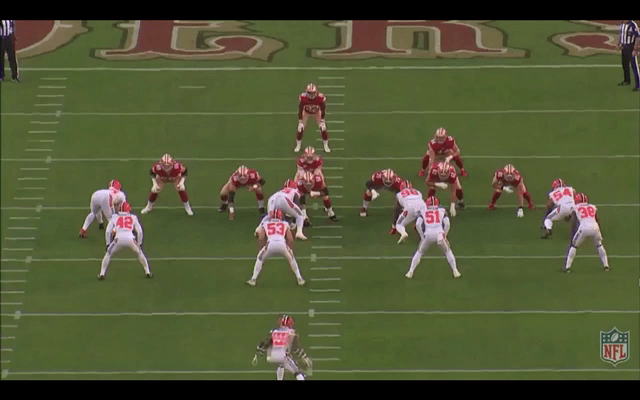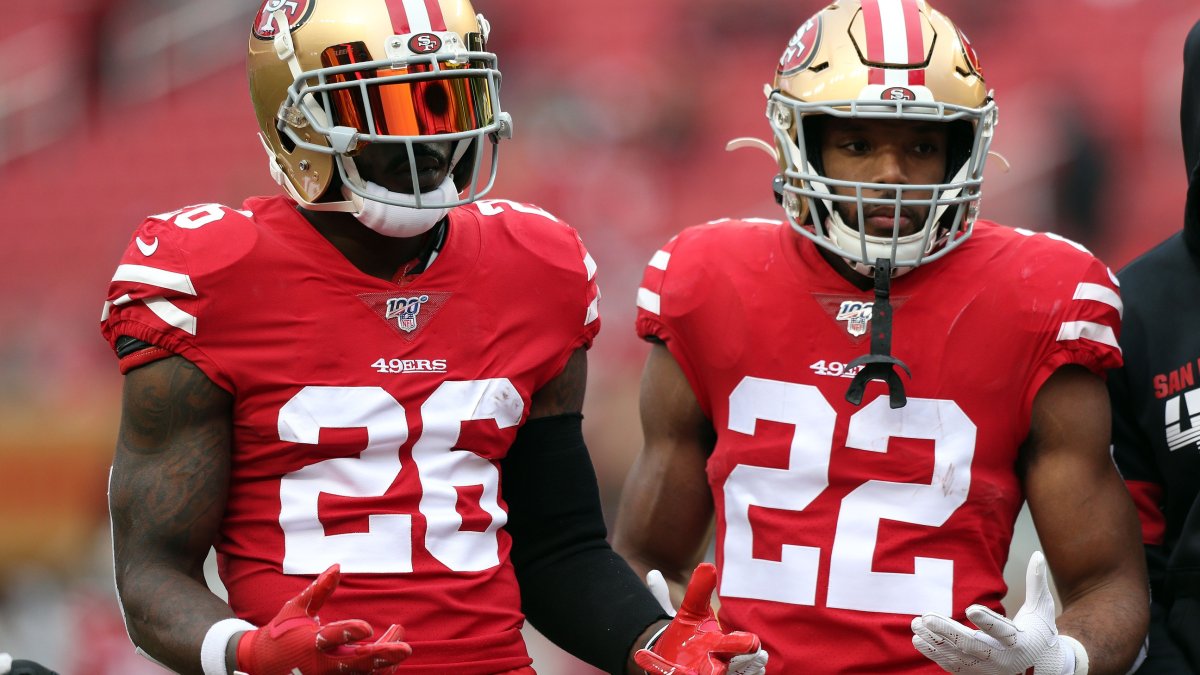What is the value of a team’s running game, and who should bear the responsibility for its production?
In years gone by, the answer would overwhelmingly have been “the running back,” as the superstar backs often garnered all the credit — and, perhaps most importantly, the majority of the compensation — but we saw a team answer differently in 2019 when the San Francisco 49ers went against the status quo by allocating a higher percentage of their salary cap toward their offensive line while dividing the rushing workload between multiple ball carriers.
Last year Raheem Mostert, Tevin Coleman and Matt Breida fueled the 49ers’ offense and provided an A-rated return on investment. Instead of overpaying one “superstar” running back to carry the load, the Niners smartly divided the labor and the money between these three players. This method of running back by committee has become a prototype for today’s modern NFL backfields, and no team has done it better than Kyle Shanahan’s 49ers.
Dollars And Sense
Last season, the San Francisco running game generated a sixth-ranked 82.8 team rushing grade and totaled 2,305 rushing yards, finishing second only to the record-setting Baltimore Ravens.
Mostert (83.3, fourth among backs), Coleman (71.3, 26th) and Breida (67.3, 36th) produced respectable PFF rushing grades while combining for 84% of the team’s rushing yards, yet they cost a combined $6,198,748 on the season, per sportrac.com, which equates to 1.10% of the salary cap per player.
Below is a list of 2019’s top salaried running backs and their production compared to the 49ers’ trio of runners.
Top-paid running backs in 2019
| Player | 2019 Rushing yards | 2019 rushing grade | Cap amount | % of salary cap |
| David Johnson | 345 | 68.9 | $9,656,250 | 4.99% |
| Todd Gurley II | 857 | 79.1 | $9,200,000 | 4.86% |
| Le’ Veon Bell | 789 | 69.9 | $8,968,750 | 4.43% |
| Leonard Fournette | 1,152 | 65.2 | $7,404,774 | 3.68% |
| Saquon Barkley | 1,003 | 76.1 | $7,089,716 | 3.62% |
| Devonta Freeman | 656 | 57.0 | $6,750,000 | 3.56% |
| Ezekiel Elliott | 1,357 | 83.1 | $6,339,655 | 3.16% |
| Giovani Bernard | 170 | 57.1 | $5,316,666 | 2.71% |
| Dion Lewis | 209 | 64.8 | $4,862,500 | 2.23% |
| Christian McCaffrey | 1,387 | 75.8 | $4,702,172 | 2.44% |
49ers’ running backs
| Player | 2019 Rushing yards | 2019 rushing grade | Cap amount | % of salary cap |
| Raheem Mostert | 772 | 83.3 | $1,983,333 | 0.86% |
| Tevin Coleman | 544 | 71.3 | $3,568,750 | 1.54% |
| Matt Breida | 623 | 67.3 | $646,668 | 0.28% |
A season ago, the NFL’s most productive running back was Carolina Panthers’ Christian McCaffrey, who led the league with 2,392 all-purpose yards while averaging 5.2 yards per touch across 453 touches, scoring 19 touchdowns in the process. His 86.6 overall grade ranked third among the 50 qualifying backs league-wide, as did his 1,387 rushing yards, while his 752 yards after contact and 2.62 yards after contact per attempt ranked ninth and 46th, respectively.
McCaffrey accounted for 2.44% of the Panthers’ salary cap and now enters into the final year of his rookie contract.
By comparison, the 49ers’ trio of running backs accounted for 3.29% of the teams’ salary cap, and they combined to produce 2,419 all-purpose yards, 19 touchdowns and an average of 6.0 yards per touch on a combined 397 touches. They earned a cumulative PFF rushing grade of 81.3, generating 1,939 rushing yards, 1,177 rushing yards after contact and an average of 2.96 yards after contact per attempt on the ground.
Following the 2020 season, Christian McCaffrey’s calculated market value will swell to an average of $18,000,00 per year in annual salary, which would force the Panthers to overpay for a declining one-back system.
Clearly, the Niners are paying smart money to three players, but if one player like McCaffrey generated their combined production totals, the cost for the same output would be incredibly higher. But by dividing the expected production among the three players, their workload can be better managed while also minimizing cost. In 2019, the 49ers almost equally distributed the ball to Mostert (151), Coleman (158) and Breida (142), which all but ensured a healthy and fresh-legged runner from week to week.
Money Well Spent
Last season, the 49ers paid their top three ball carries an average salary of $2,066,249.33, so their commitment to investing in their offensive line was proven by the annual average salary, $6,586,294, that was paid to their starting front five.
Their average salary cap percentage of 11.58% per player among their top-paid offensive linemen last year also far exceeded the average 1.10% cap percentage for Mostert, Coleman and Breida.
| Player | PFF run-blocking grade | Cap amount | Adj. cap percentage |
| LT Joe Staley | 76.5 | $14,418,750 | 6.24% |
| LG Laken Tomlinson | 67.7 | $3,750,000 | 1.62% |
| C Weston Richburg | 58.1 | $7,844,142 | 3.39% |
| RG Mike Person | 62.8 | $2,750,000 | 1.19% |
| RT Mike McGlinchey | 73.7 | $4,168,580 | 1.80% |
The 49ers’ offensive line paved the way for an excellent return on investment last year, earning a 75.3 team run-blocking grade that ranked fourth among the league’s 32 teams.
Kyle Shanahan dialed up 498 run plays last year, the second-most in the NFL, and the offensive line led the way for an eighth-ranked 4.6 yards per carry, 64 explosive run plays of 10-plus yards (second) and a league-high 28 rushing touchdowns. They finished the season with a third-ranked 868 rushing yards before contact while producing the league's fourth-best average of 1.7 yards before contact per rush attempt.
The 49ers’ well-balanced offense invited eight or more defenders on 60.8% of their total 498 run plays, but even that didn’t stop the team’s ground attack from dominating.
2019 San Francisco 49ers’ offensive line vs. eight or more defenders in the box
| Stat | Rank | |
| Total rushing attempts | 303 | 1st of 32 |
| PFF Run-block grade | 67.8 | 7th of 32 |
| Total rushing yards | 1,310 | 2nd of 32 |
| Yards per carry | 4.3 | 5th of 32 |
| EPA per rush attempt | -0.066 | 7th of 32 |

Learning it the hard way
The 49ers’ offense uses both a zone and man running scheme that is well-suited for any player who is patient and willing to commit to the game plan of attacking downhill without hesitation.
Known as a running back-friendly system, Shanahan instructs his backs on precision footwork and synchronized timing where the runner must attack the line as all five linemen engage their blocking assignments. The burden of responsibility falls on the offensive linemen to generate movement on the line of scrimmage, and the runner is asked to stick one foot in the ground and trust there will be an opening as he approaches the line. It is a well-timed, choreographed operation that places value on the whole unit, instead of individual parts.
Just like the Los Angeles Rams and Arizona Cardinals, who overpaid for an underachieving one-man production system with Todd Gurley and David Johnson, respectively, the 49ers have learned a tough lesson after suffering through their own share of buyer’s remorse.
After signing free agent running back Jerick McKinnon to a four-year, $30 million contract ($18m guaranteed) in 2018, he later suffered a major knee injury and has spent each of the last two seasons on the Injured Reserve without playing in a single regular-season game since joining the team. As a result, the 49ers have learned to proceed cautiously when allocating resources towards an asset that can rapidly depreciate.
Just as the Niners did a season ago, the smart money says that teams implement a player-friendly system, then spread the workload and salary among multiple players in the offensive backfield. Other teams should quickly follow suit.



 © 2024 PFF - all rights reserved.
© 2024 PFF - all rights reserved.